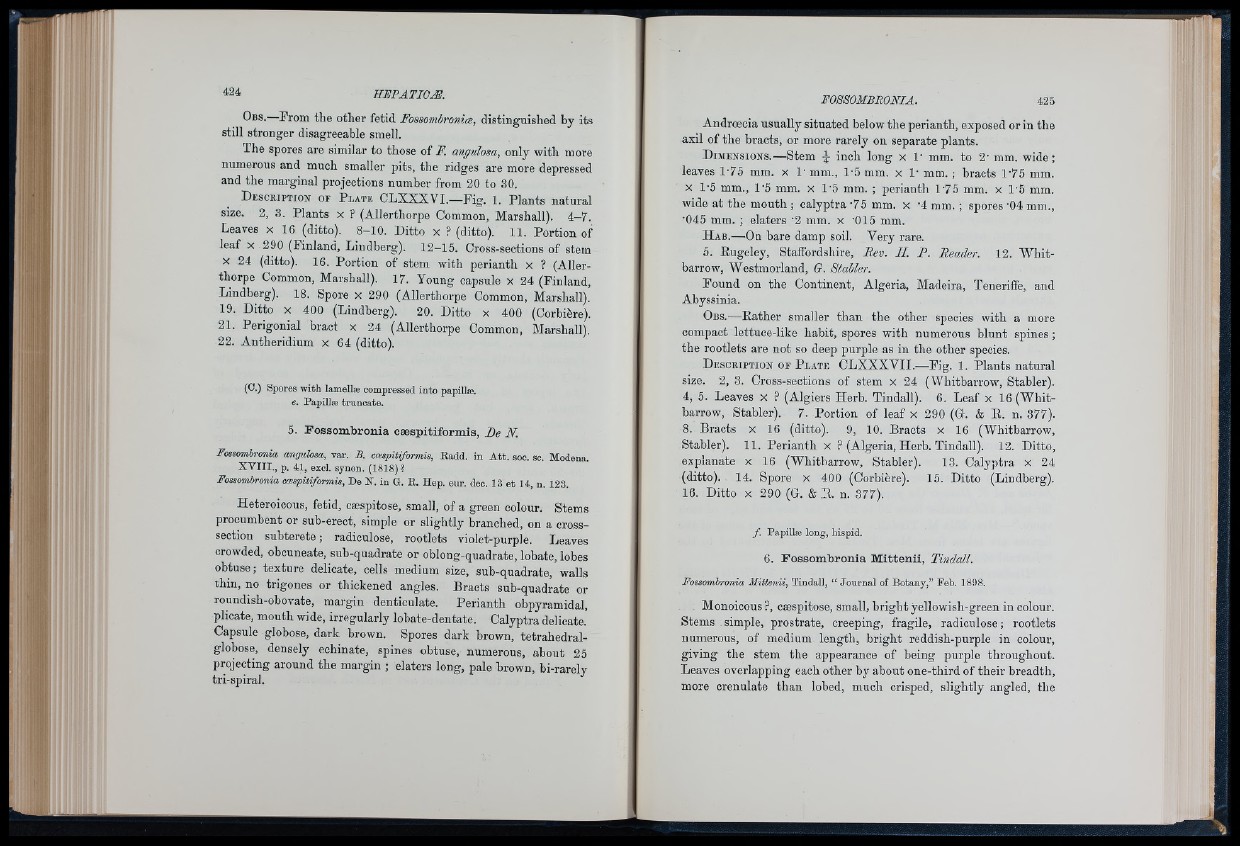
0®®- From the other fetid Fossombroniæ, distinguished by its
still stronger disagreeable smell.
The spores are similar to those of F. angulosa, only with more
numerous and much smaller pits, the ridges are more depressed
and the marginal projections number from 20 to 30.
D e sc r ip t io n of P la t e OLXXXVI.—Fig. 1. Plants natural
size. 2, 3. Plants x I (Allerthorpe Common, Marshall). 4—7.
Leaves x 16 (ditto). 8-10. Ditto x »(ditto). 11. Portion of
leaf X 290 (Finland, Lindberg). 12-15. Cross-sections of stem
X 24 (ditto). 16. Portion of stem with perianth x ? (Allerthorpe
Common, Marshall). 17. Young capsule x 24 (Finland,
Lindberg). 18. Spore x 290 (Allerthorpe Common, Marshall).’
19. Ditto X 400 (Lindberg). 20. Ditto x 400 (Corbière).
21. Perigonial braot x 24 (Allerthorpe Common, Marshall).
22. Antheridium x 64 (ditto).
(0.) Spores w ith lamellæ compressed into papillæ.
e. Papillæ truncate.
5. Fossombronia cæspitiformis, Be N.
Fossomhronia angulosa, var. B. cæspitiformis, Eadd. in A tt. soe. sc. Modena.
X V I I I ., p. 41, excl. synon. (1818) ?
Fossomhronia cæspitiformis, De N. in G. E . Hep. eur. dec. 13 e t 14, n. 123.
Heteroicous, fetid, cæspitose, small, of a green colour. Stems
procumbent or sub-erect, simple or slightly branched, on a cross-
section suhterete; radiculose, rootlets violet-purple. Leaves
crowded, obcuneate, sub-quadrate or oblong-quadrate, lobate, lobes
obtuse; texture delicate, cells medium size, sub-quadrate, walls
thin, no trigones or thickened angles. Bracts sub-quadrate or
roundish-obovate, margin denticulate. Perianth obpyramidal,
plicate, mouth wide, irregularly lobate-dentate. Calyptra delicate.
Capsule globose, dark brown. Spores dark brown, tetrahedral-
globose, densely echinate, spines obtuse, numerous, about 25
projecting around the margin ; elaters long, pale brown, bi-rarely
tri-spiral.
Androeoia usually situated below the perianth, exposed or in the
axil of the bracts, or more rarely on separate plants.
D im e n s io n s .—Stem ¿ inch long x I" mm. to 2‘ mm. wide;
leaves 175 mm. x 1' mm., lA mm. x 1- mm. ; braots 175 mm.
X lA mm., lA mm. x lA mm. ; perianth 175 mm. x lA mm.
wide at the mouth ; calyptra 7 5 mm. x '4 ram. ; spores '04 mm.,
•045 mm. ; elaters -2 mm. x -015 mm.
H ab.—-On bare damp soil. Very rare.
5. Kugeley, Staffordshire, Bev. H. P. Reader. 12. W h itbarrow,
Westmorland, G. Stabler.
Pound on the Continent, Algeria, Madeira, Teneriffe, and
Abyssinia.
Obs.—Ba th e r smaller th an th e other species with a more
compact lettuce-like habit, spores with numerous b lu n t spines ;
the rootlets are not so deep purple as in the other species.
D e s c r ip t io n or P late CLXXXVII.—Pig. 1. Plants natural
size. 2, 3. Cross-sections of stem x 24 (Whitbarrow, Stahler).
4, 5. Leaves x ? (Algiers Herb. Tindall). 6. Leaf x 16 (Whitbarrow,
Stabler). 7. Portion of leaf x 290 (G. & E. n. 377).
8. Bracts x 16 (ditto). 9, 10. Bracts x 16 (Whitbarrow,
Stabler). 11. Perianth x ? (Algeria, Herb. Tindall). 12. Ditto,
explanate x 16 (Whitbarrow, Stabler). 13. Calyptra x 24
(ditto). 14. Spore x 400 (Corbière). 15. Ditto (Lindberg).
16. Ditto X 290 (G. & E. n. 377).
Fossomhronia
f. Papillæ long, hispid.
6. Fossombronia Mittenii, Tindall,
ii, Tindall, “ Jo u rn a l of Botany,” Feb. 1898.
Monoicous ?, cæspitose, small, bright yellowish-green in colour.
Stems simple, prostrate, creeping, fragile, radiculose ; rootlets
numerous, of medium length, bright reddish-purple in colour,
giving the stem the appearance of being purple throughout.
Leaves overlapping each other by about one-third of their breadth,
more crenulate than lobed, much crisped, slightly angled, the